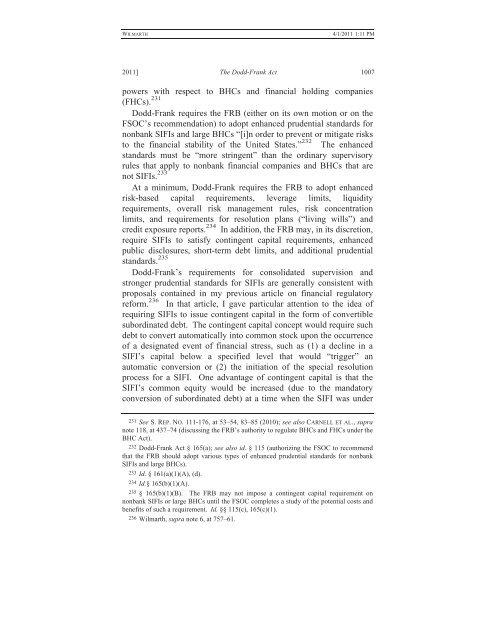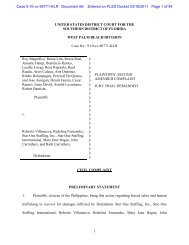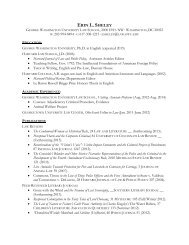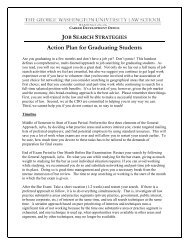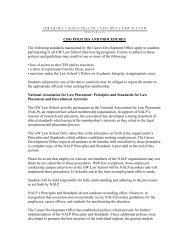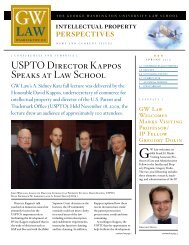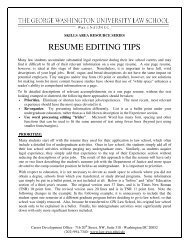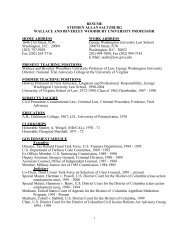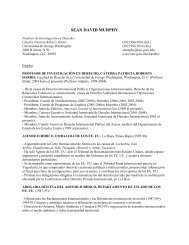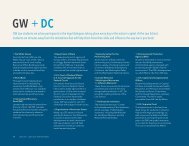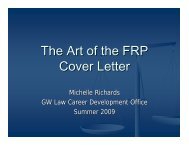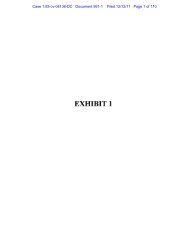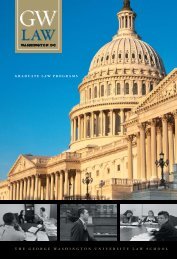CLE Materials for Panel #1 - George Washington University Law ...
CLE Materials for Panel #1 - George Washington University Law ...
CLE Materials for Panel #1 - George Washington University Law ...
You also want an ePaper? Increase the reach of your titles
YUMPU automatically turns print PDFs into web optimized ePapers that Google loves.
WILMARTH<br />
4/1/2011 1:11 PM<br />
2011] The Dodd-Frank Act 1007<br />
powers with respect to BHCs and financial holding companies<br />
(FHCs). 231<br />
Dodd-Frank requires the FRB (either on its own motion or on the<br />
FSOC’s recommendation) to adopt enhanced prudential standards <strong>for</strong><br />
nonbank SIFIs and large BHCs “[i]n order to prevent or mitigate risks<br />
to the financial stability of the United States.” 232 The enhanced<br />
standards must be “more stringent” than the ordinary supervisory<br />
rules that apply to nonbank financial companies and BHCs that are<br />
not SIFIs. 233<br />
At a minimum, Dodd-Frank requires the FRB to adopt enhanced<br />
risk-based capital requirements, leverage limits, liquidity<br />
requirements, overall risk management rules, risk concentration<br />
limits, and requirements <strong>for</strong> resolution plans (“living wills”) and<br />
credit exposure reports. 234 In addition, the FRB may, in its discretion,<br />
require SIFIs to satisfy contingent capital requirements, enhanced<br />
public disclosures, short-term debt limits, and additional prudential<br />
standards. 235<br />
Dodd-Frank’s requirements <strong>for</strong> consolidated supervision and<br />
stronger prudential standards <strong>for</strong> SIFIs are generally consistent with<br />
proposals contained in my previous article on financial regulatory<br />
re<strong>for</strong>m. 236 In that article, I gave particular attention to the idea of<br />
requiring SIFIs to issue contingent capital in the <strong>for</strong>m of convertible<br />
subordinated debt. The contingent capital concept would require such<br />
debt to convert automatically into common stock upon the occurrence<br />
of a designated event of financial stress, such as (1) a decline in a<br />
SIFI’s capital below a specified level that would “trigger” an<br />
automatic conversion or (2) the initiation of the special resolution<br />
process <strong>for</strong> a SIFI. One advantage of contingent capital is that the<br />
SIFI’s common equity would be increased (due to the mandatory<br />
conversion of subordinated debt) at a time when the SIFI was under<br />
231 See S. REP. NO. 111-176, at 53–54, 83–85 (2010); see also CARNELL ET AL., supra<br />
note 118, at 437–74 (discussing the FRB’s authority to regulate BHCs and FHCs under the<br />
BHC Act).<br />
232 Dodd-Frank Act § 165(a); see also id. § 115 (authorizing the FSOC to recommend<br />
that the FRB should adopt various types of enhanced prudential standards <strong>for</strong> nonbank<br />
SIFIs and large BHCs).<br />
233 Id. § 161(a)(1)(A), (d).<br />
234 Id.§ 165(b)(1)(A).<br />
235 § 165(b)(1)(B). The FRB may not impose a contingent capital requirement on<br />
nonbank SIFIs or large BHCs until the FSOC completes a study of the potential costs and<br />
benefits of such a requirement. Id. §§ 115(c), 165(c)(1).<br />
236 Wilmarth, supra note 6, at 757–61.


